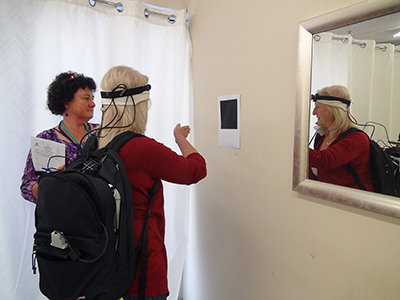Research
My adventure into research began in nappyland. I have since roamed with low vision and scooters in Dandenong, watched trams with a bionic eye in Melbourne, discovered what’s great about guide dogs, and measured functional vision and mobility in Malaysia.
Learning to Breastfeed
When my babies were little, I conceived the idea for a book about breastfeeding and early mothering, started collecting stories (n=70) and picked up a co-author along the way. I learned to listen and appreciate that other people’s experience is different from my own, and equally valid. In the process of learning about cabbage leaves and qualitative research, I also learned a lot about publishing.
In 2004, Debbie Tuck and I published Learning to breastfeed: Women’s stories about boobs, babes and being a mum.
Books about O&M
Back at GDV I found myself immersed in a thriving, collaborative workplace culture that fostered and rewarded my initiative. I learned to write, co-write and edit in more genres, including university curricula, theses, reports, children’s activity books, professional training manuals and peer reviewed publications. I worked with collaborators to publish two children’s activity books about functional vision and O&M.
While developing curriculum and teaching the Graduate Diploma in O&M at La Trobe University, my colleagues and I developed a manual for trainee O&M specialists.
- Orientation and Mobility Methods: Techniques for Independent Travel
Scooter Project
While looking for a topic for my Masters thesis, a colleague prompted some important questions about motorised mobility scooters:
- How much vision is needed for safe travel using a scooter?
- What do O&M specialists need to know, to work effectively with scooter clients?
We made some early attempts to investigate the first question, but found it had to wait. Clinical vision measures were inadequate, and we didn’t yet have an integrated measure of functional vision for use in O&M assessments. Instead, I investigated the experience and readiness of O&M specialists in Australia and New Zealand to work with scooter clients.
Measuring Functional Vision in O&M
My PhD project helped to tease out salient differences between clinical and functional approaches to assessment. I finally worked out how to assess functional vision in person-centred O&M assessment in lived environments. The result was two constructivist assessment tools called VROOM and OMO.
These tools standardise professional practices, recording and rating methods, without standardising assessment venues or assessment tasks. The client is free to show what he or she typically does in ordinary environments, and the resulting scores from using these tools are robust, meaningful and comparable.
Benefits of Guide Dog Mobility
While finishing my doctoral thesis, I began a research project investigating the Benefits of GD Mobility that was a collaboration between GDV and Swinburne University. This provided an opportunity to pilot the VROOM and OMO tools with guide dog handlers (N=51).
Optimising technology in O&M
I worked with a multi-disciplinary group at Swinburne to apply successfully for a two year digital health grant. The Melbourne-Sarawak Research Collaboration Scheme enabled us to validate the VROOM and OMO functional assessment tools while optimising the use of technology for the benefit of O&M clients and professionals. I continue this Swinburne relationship as an adjunct research fellow.
I teach O&M specialists to use the VROOM and OMO tools, and work with the Swinburne team and with O&M colleagues to analyse the functional implications of VROOM and OMO data. I am delighted to have keen industry-based research partners in Australia and the UK to further this work.
Research Wishlist
I am looking for opportunities and partners to undertake further research investigating:
- scooter use with low vision
- spatial cognition using the Stuart Tactile Maps, spatial dysfunction and its implications for O&M practice
- wider application of the VROOM and OMO tools as a way to capture practice-based evidence of the benefits of O&M training
- guide dog mobility
- pathways from adolescence to adulthood, involving launching from home, finding stable housing, embracing formal education, and discovering what constitutes meaningful work, both paid and unpaid
